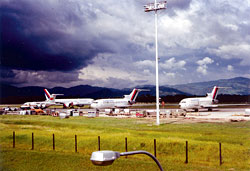 A yawning gap between the salaries of pilots in state-owned Royal Nepal Airlines and private carriers as well as a growing demand for crew in India is threatening to ground the national airline.
A yawning gap between the salaries of pilots in state-owned Royal Nepal Airlines and private carriers as well as a growing demand for crew in India is threatening to ground the national airline.
arlier this month, headhunters from the Madras-based Blue Dart airline were in Kathmandu and interviewed 12 Boeing 757 pilots from Royal Nepal Airlines. They will shortlist six captains and the loss of so many 757 pilots could hurt the airline's international operations.
After Air Sahara inducted Boeing 767s, at least half a dozen Royal Nepal 757 pilots were ready to go over. The only thing stopping them was Indian civil aviation rules that don't allow easy conversion of a 757 license to 767.
This comes as Royal Nepal's domestic STOL crew have been on the warpath demanding pay at par with private carriers. They called off a threatened strike on 31 December after the management promised to look into their grievances.
The average take home pay of a 757 captain with Royal Nepal Airlines flying 50 hours a month is only NRs 55,000. A 737 captain with India's private Jet Airways earns anywhere up to IRs 450,000.
The gap is even more glaring for pilots flying Royal Nepal's Twin Otters on domestic routes who earn just NRs 50,000 while a STOL pilot of private airlines can take home NRs 200,000.
Last year, senior Royal Nepal captains who faced mandatory retirement at 58 according to civil service rules went to a Thai charter carrier where they can fly till 60. 'At this rate RNAC will soon loose all its pilots unless the Operations Department takes immediate steps to convince the management, the ministry and the board to restructure salaries and perks of cockpit crews,' warns a confidential report prepared for the airline's board by a committee.
Royal Nepal Airline's general manager, Mohan Khanal admits there is a salary gap but says his pilots have other medical, retirement and holiday benefits that are not counted. "It's true our pilots are in hot demand but we are looking at their demands positively," Khanal told us.
Indeed, the problem of pilot salaries is just part of a larger malaise that has chronically afflicted the national carrier. From being a trendsetter in the South Asian region by buying two brand new 757s in 1985, the carrier was plagued by political interference and saw steady decline.
The airline's 'golden years' were in the late 1980s when it had a fleet of four jets, 11 Twin Otters, three Avros and two Pilatus Porters. After the restoration of democracy in 1990, the airline became a cash cow for unscrupulous politicians and their cronies who siphoned off kickbacks on inappropriate aircraft leases instead of adding 767s according to the airline's growth strategy. In cahoots with politicians, managers sold off two 727s and all spare parts for a pittance in 1992.
Capt Vijay Lama who has been flying with Royal Nepal for 18 years says there is still hope if the airline is allowed to plan independently and be competitive. "We are lucky because I think His Majesty King Gyanendra is committed to making the airline strong again and Minister Yankila Sherpa is supportive and positive," he told us.
The report presented to the board lays out a list of immediate and medium-term measures to rescue the airline: urgently addressing the haemmorhage of pilots with salary increases and fleet progression, investing in new crew training, expanding the fleet with at least two turboprops for domestic trunk routes and a third 757 plus a long-range widebody for the Japan route.
It emphasises a creative new marketing strategy and details revenue sources like reviving mountain flights, operating more tourist sectors and adding frequency to traditional money spinners like the Delhi and Hong Kong routes.
PIC CAPTION: GOOD OLD DAYS: A Royal Nepal Airlines 757 taxies part two of its 727s when the airline had more than 20 planes in its fleet. PIC: KUNDA DIXIT


